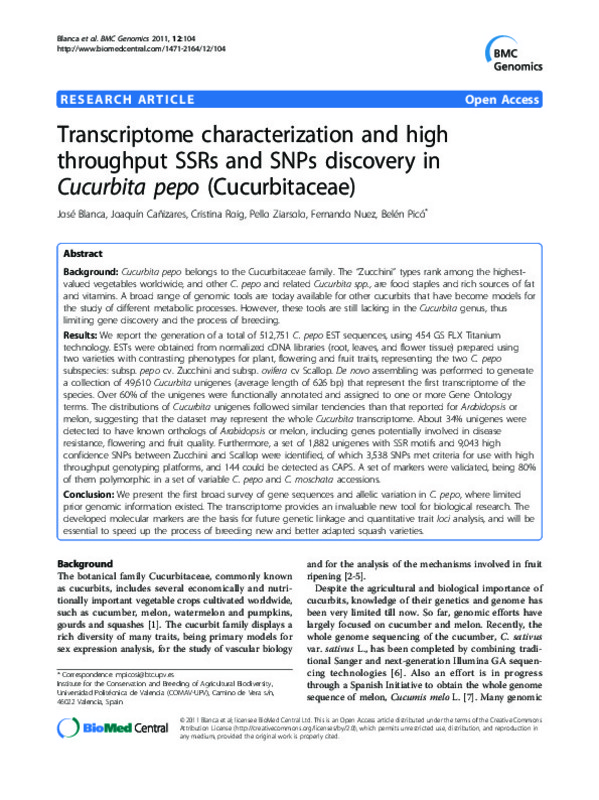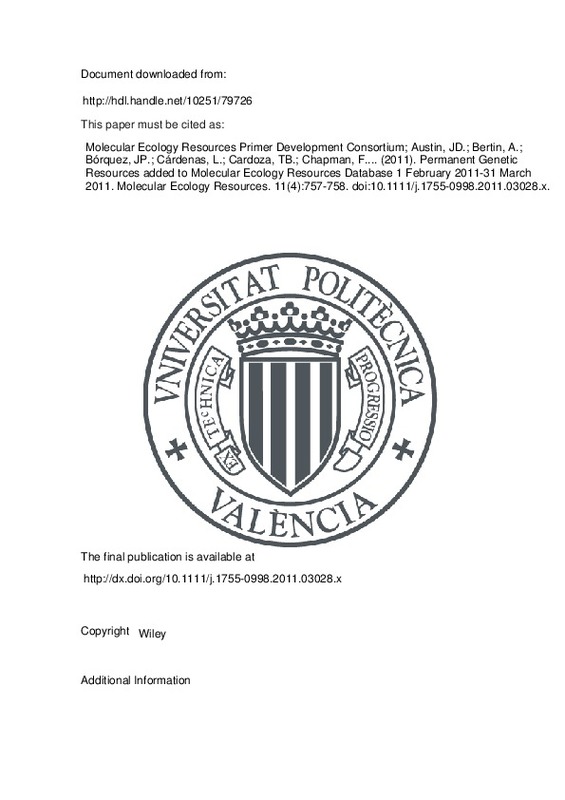|
Resumen:
|
Background: Cucurbita pepo belongs to the Cucurbitaceae family. The "Zucchini" types rank among the highest-valued vegetables worldwide, and other C. pepo and related Cucurbita spp., are food staples and rich sources of ...[+]
Background: Cucurbita pepo belongs to the Cucurbitaceae family. The "Zucchini" types rank among the highest-valued vegetables worldwide, and other C. pepo and related Cucurbita spp., are food staples and rich sources of fat and vitamins. A broad range of genomic tools are today available for other cucurbits that have become models for the study of different metabolic processes. However, these tools are still lacking in the Cucurbita genus, thus limiting gene discovery and the process of breeding.Results: We report the generation of a total of 512,751 C. pepo EST sequences, using 454 GS FLX Titanium technology. ESTs were obtained from normalized cDNA libraries (root, leaves, and flower tissue) prepared using two varieties with contrasting phenotypes for plant, flowering and fruit traits, representing the two C. pepo subspecies: subsp. pepo cv. Zucchini and subsp. ovifera cv Scallop. De novo assembling was performed to generate a collection of 49,610 Cucurbita unigenes (average length of 626 bp) that represent the first transcriptome of the species. Over 60% of the unigenes were functionally annotated and assigned to one or more Gene Ontology terms. The distributions of Cucurbita unigenes followed similar tendencies than that reported for Arabidopsis or melon, suggesting that the dataset may represent the whole Cucurbita transcriptome. About 34% unigenes were detected to have known orthologs of Arabidopsis or melon, including genes potentially involved in disease resistance, flowering and fruit quality. Furthermore, a set of 1,882 unigenes with SSR motifs and 9,043 high confidence SNPs between Zucchini and Scallop were identified, of which 3,538 SNPs met criteria for use with high throughput genotyping platforms, and 144 could be detected as CAPS. A set of markers were validated, being 80% of them polymorphic in a set of variable C. pepo and C. moschata accessions.Conclusion: We present the first broad survey of gene sequences and allelic variation in C. pepo, where limited prior genomic information existed. The transcriptome provides an invaluable new tool for biological research. The developed molecular markers are the basis for future genetic linkage and quantitative trait loci analysis, and will be essential to speed up the process of breeding new and better adapted squash varieties. © 2011 Blanca et al; licensee BioMed Central Ltd.
[-]
|
|
Palabras clave:
|
Complementary DNA
,
Transcriptome
,
Microsatellite DNA
,
Plant DNA
,
Allele
,
Arabidopsis
,
Article
,
DNA library
,
DNA sequence
,
Expressed sequence tag
,
Flowering
,
Gene expression
,
Genetic variability
,
Genotype
,
Nonhuman
,
Phenotype
,
Scallop
,
Simple sequence repeat
,
Single nucleotide polymorphism
,
Squash
,
Transcriptomics
,
Flower
,
Gene expression profiling
,
Gene library
,
Genetics
,
Molecular genetics
,
Plant gene
,
Plant leaf
,
Plant root
,
Cucumis
,
Cucurbita
,
Cucurbita moschata
,
Cucurbita pepo
,
Cucurbita pepo var. melopepo
,
Cucurbitaceae
,
Pepo
,
DNA, Plant
,
Flowers
,
Genes, Plant
,
Microsatellite Repeats
,
Molecular Sequence Annotation
,
Plant Leaves
,
Plant Roots
,
Polymorphism, Single Nucleotide
,
Sequence Analysis, DNA
|











